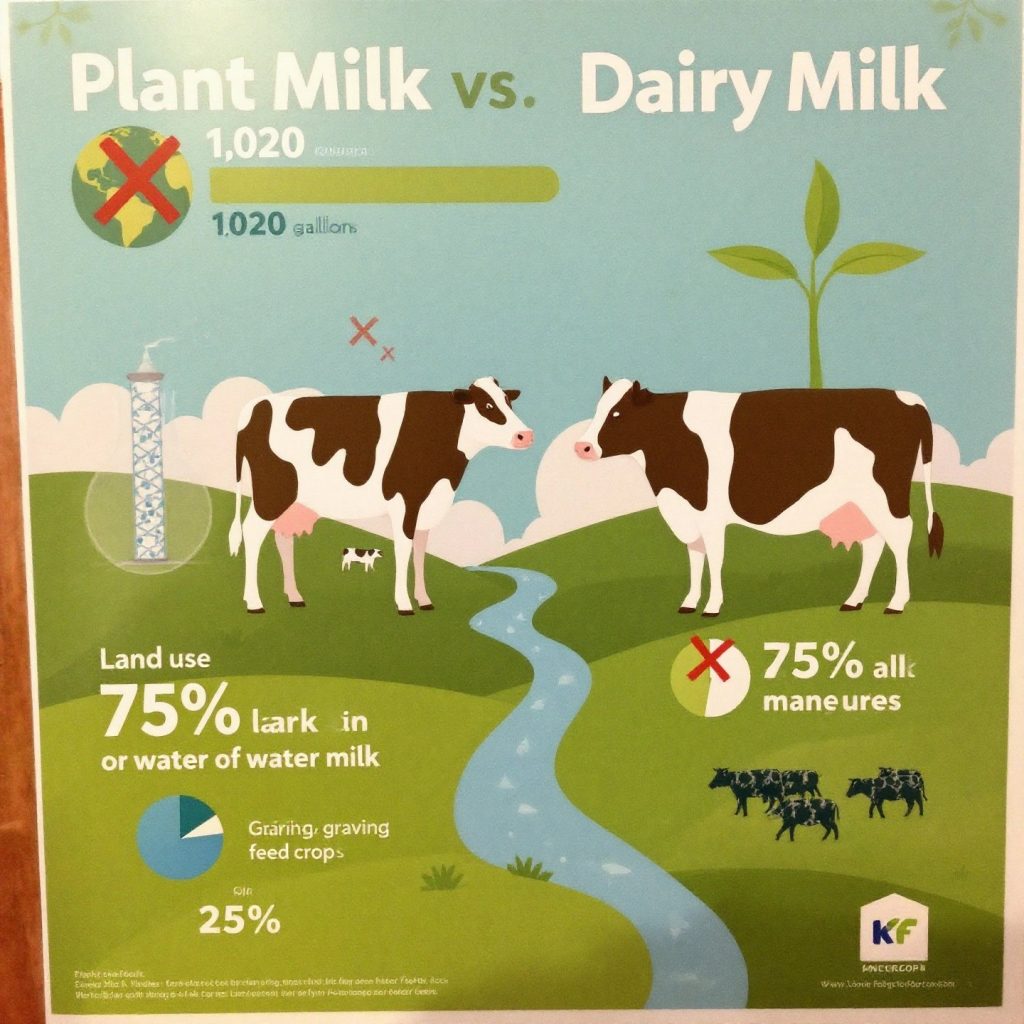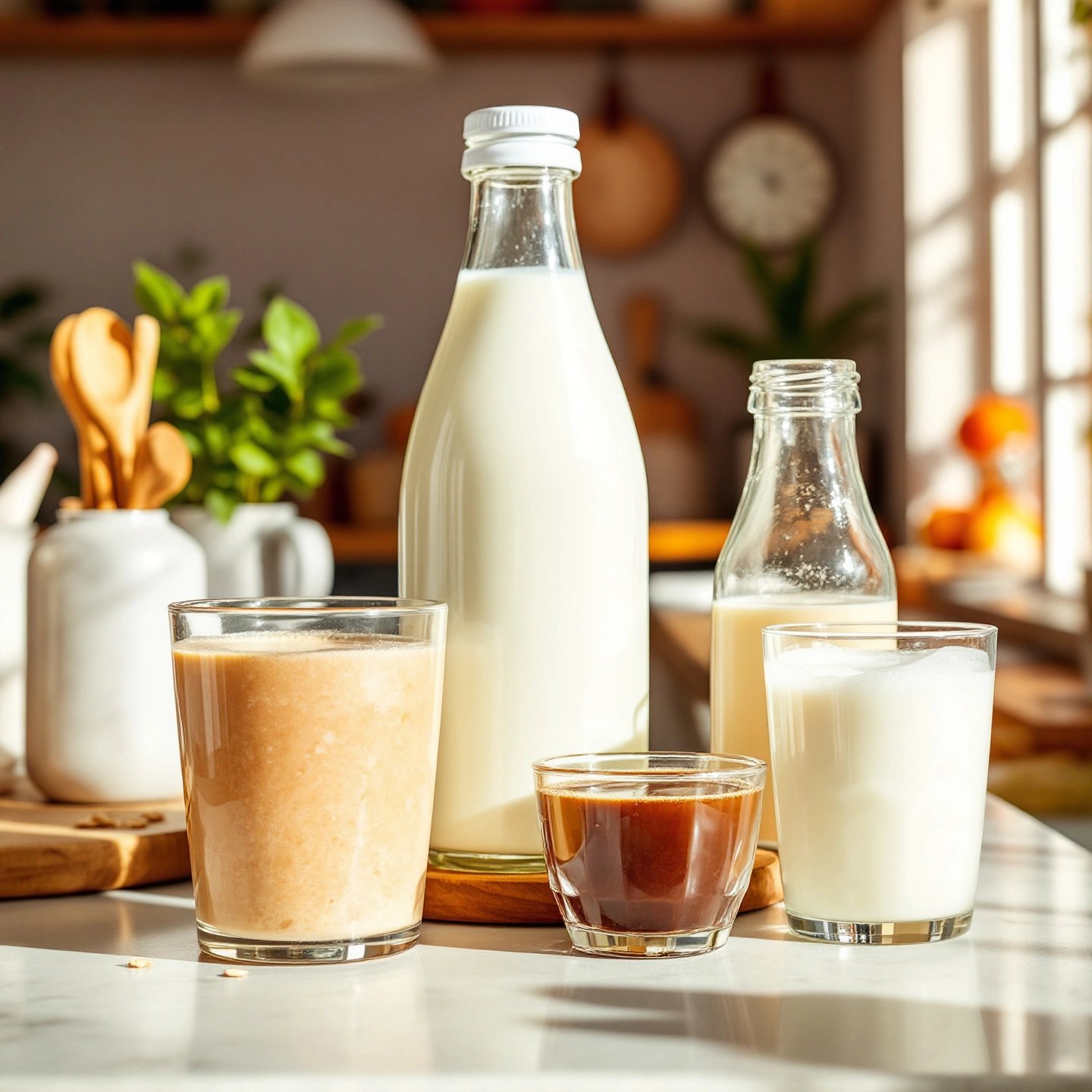Introduction to Plant Milk: A Growing Trend in Non-Dairy Milk Options
Plant milk, often referred to as plant-based milk alternatives, has become a staple in many households, offering a versatile and nutritious option for those seeking to reduce or eliminate dairy from their diets. Unlike traditional cow’s milk, plant milk is derived from various plant sources, such as nuts, seeds, grains, and legumes. These milk alternatives have been a part of human diets for centuries, with historical records of almond and soy milk dating back to medieval times in Europe and China, respectively (Wikipedia).
The significance of plant milk as a non-dairy alternative lies in its ability to cater to a wide range of dietary needs and preferences. Many consumers opt for plant milk due to lactose intolerance, a common condition affecting millions worldwide. For these individuals, consuming dairy can lead to digestive discomfort, making plant-based options a preferable choice . Moreover, plant milk aligns with vegan and vegetarian lifestyles, as it is free from animal products, thereby supporting ethical dietary choices.
Environmental concerns also play a significant role in the growing popularity of plant milk. The production of plant-based milk generally requires less water and land compared to dairy farming, which is known for its high resource consumption and significant greenhouse gas emissions. For instance, producing a gallon of cow’s milk can consume up to 976 gallons of water, whereas plant milks like oat and soy have a much lower environmental footprint (WebMD). This makes plant milk a sustainable choice for environmentally conscious consumers.
As the demand for plant-based milk alternatives continues to rise, consumers are encouraged to explore the diverse options available, each offering unique flavors and nutritional benefits. This exploration not only supports personal health goals but also contributes to broader efforts in reducing environmental impact and promoting animal welfare.

Common types of plant milks: almond, soy, oat, and hemp, each with unique flavors and uses (AI-generated)
Common Types of Plant Milks: Exploring Nut, Seed, and Grain-Based Options
Plant milk comes in a diverse array of types, each offering unique flavors, nutritional profiles, and culinary uses. With increasing demand for non-dairy alternatives, it’s important to understand the variety of options available, from nut-based to seed and grain-based plant milks.
Nut-Based Plant Milks
Among the most popular types of plant milk are those derived from nuts, such as almond, cashew, and hazelnut milk. Almond milk, with its light, nutty flavor, is a staple in many households and is particularly favored for its low calorie and fat content. It is rich in vitamin E and often fortified with calcium, making it a nutritious choice for cereal, smoothies, and baking (Tasting Table).
Cashew milk, known for its creamy texture, is versatile in both sweet and savory dishes, from soups to desserts. It is low in calories and contains heart-healthy fats, making it a great addition to a balanced diet. Hazelnut milk, on the other hand, offers a rich, indulgent flavor that pairs excellently with chocolate-based recipes, enhancing the taste of coffee, hot cocoa, and baked goods (Switch4Good).
Seed-Based Plant Milks
Seed-based milks, such as hemp and flax milk, are gaining popularity due to their nutritional benefits. Hemp milk is a powerhouse of omega-3 and omega-6 fatty acids, providing all essential amino acids, which makes it a complete protein source. It’s an excellent option for those with nut allergies and works well in smoothies and cereals.
Flax milk, another seed-based option, is rich in omega-3 fatty acids and often fortified with vitamins A, D, and B12. Its mild flavor makes it suitable for various culinary applications, including baking and cooking (Switch4Good).
Grain-Based Plant Milks
Grain-based milks, such as oat and rice milk, are also popular choices. Oat milk, known for its creamy texture and slightly sweet taste, has become a favorite in coffee shops due to its excellent frothing ability. It is often fortified with vitamins and minerals, making it a nutritious choice for coffee, cereal, and baking (Tasting Table).
Rice milk is another hypoallergenic option, appreciated for its light consistency and subtle sweetness. It is ideal for those with allergies to nuts and soy and can be used in smoothies, sauces, and desserts.
With such a wide range of types of plant milk, consumers are encouraged to experiment with different varieties to discover their preferred flavors and textures. Each type offers distinct benefits and can be used creatively in various culinary applications, making plant milk a versatile addition to any diet.
Nutritional Comparison: Understanding Plant Milk Vitamins and Minerals
Plant milk offers a diverse array of nutritional profiles, providing a viable alternative to traditional dairy milk. Understanding the nutritional benefits of plant milk is essential for consumers looking to make informed dietary choices. Each type of plant milk comes with its own unique set of macronutrients, vitamins, and minerals, catering to a variety of dietary needs and preferences.
Macronutrients in Plant Milk
One of the primary considerations for choosing plant milk is its macronutrient content. Soy milk, for instance, is renowned for its high protein content, offering around 7 to 10 grams per eight-ounce serving, closely resembling the protein level found in cow’s milk. This makes it an excellent choice for those seeking to maintain or increase their protein intake (University of Utah Health). On the other hand, almond and rice milk are lower in protein, with almond milk providing about 1 gram per serving, making them suitable for those on a low-protein diet.
In terms of carbohydrates, oat milk stands out with its higher carbohydrate content, which can be beneficial for those needing extra energy, such as athletes. Rice milk also has a higher carbohydrate content, making it an option for those who require easily digestible energy sources.
Vitamins and Minerals: Fortification and Natural Content
Many plant milks are fortified with essential vitamins and minerals to enhance their nutritional profile. Fortification typically includes calcium and vitamin D, which are crucial for bone health. For example, soy and almond milk are often fortified with these nutrients to mimic the nutritional benefits of dairy milk (Plant Based Juniors). Additionally, some plant milks may include added vitamins such as B12 and A, which are important for maintaining energy levels and supporting immune function.
Oat milk naturally contains vitamins such as A and B, along with minerals like potassium and magnesium, which support various bodily functions. However, it is still advisable to check the packaging for fortification details to ensure adequate intake of necessary nutrients.
Addressing Dietary Needs and Allergens
When selecting plant milk, it is important to consider potential allergens and dietary restrictions. Soy milk is an excellent option for those who are lactose intolerant but should be avoided by individuals with soy allergies. Almond and other nut-based milks are not suitable for those with nut allergies, whereas oat and rice milk offer hypoallergenic alternatives.
Understanding the nutritional benefits of plant milk can guide consumers in selecting the best option for their dietary needs. Whether seeking to boost protein intake, enhance vitamin and mineral consumption, or avoid allergens, the variety of plant milks available today ensures that there is a suitable choice for everyone. As we continue exploring the diverse world of plant milk, it is essential to consider both nutritional content and personal dietary requirements.

Comparative environmental impact of plant milk versus dairy milk, highlighting sustainability (AI-generated)
Environmental Impact of Plant Milk: A Sustainable Choice
The environmental impact of plant milk has become a significant consideration for consumers seeking sustainable milk alternatives. Compared to traditional dairy milk, plant-based options generally offer a more eco-friendly profile, addressing concerns about water usage, land use, and carbon emissions.
Water Usage and Conservation
Water consumption is a critical factor in assessing the environmental footprint of milk production. Dairy milk requires a substantial amount of water, with estimates suggesting that producing a gallon of cow’s milk can use up to 976 gallons of water. In contrast, plant milks such as oat and soy require significantly less water. For instance, oat milk is noted for its low water footprint, making it a sustainable choice for environmentally conscious consumers. However, it’s important to note that almond milk, despite its popularity, has a higher water requirement, which can be a concern in water-scarce regions (Our World in Data).
Land Use Efficiency
Land use is another critical metric where plant milks excel. Dairy farming demands extensive land resources, not only for the cattle but also for growing feed crops. Plant-based milks, on the other hand, require significantly less land. For example, producing soy milk uses less than a tenth of the land needed for dairy milk production, highlighting its efficiency and lower environmental impact. This reduced land use contributes to less deforestation and habitat destruction, making plant milks a more sustainable option (Bastyr University).
Greenhouse Gas Emissions
Greenhouse gas emissions are a major concern in dairy production, contributing significantly to global warming. Cow’s milk production is associated with higher emissions due to methane released by cattle and the energy-intensive processes involved in dairy farming. Plant milks, such as soy and oat, produce much lower greenhouse gas emissions. Soy milk, in particular, is recognized for its minimal carbon footprint when sourced responsibly. Consumers can further reduce their environmental impact by choosing plant milks packaged in recyclable materials (Bastyr University).
Sustainability Considerations
When selecting a plant milk, consumers should consider their environmental values and regional resources. Opting for locally produced plant milks can further reduce the environmental impact by minimizing transportation emissions. Additionally, choosing organic options can help avoid the use of harmful pesticides that may pollute soil and water sources.
In conclusion, the environmental impact of plant milk presents a compelling case for those seeking sustainable milk alternatives. By understanding the nuances of water usage, land efficiency, and carbon emissions, consumers can make informed decisions that align with their environmental goals. As we transition to the next section, we will explore the culinary uses of plant milk, offering practical insights into how these sustainable options can be integrated into everyday cooking and baking.
Culinary Uses and Applications: Cooking with Plant Milk
Plant milk offers a versatile alternative to traditional dairy, excelling in various culinary applications from drinking to cooking, baking, and frothing. Each type of plant milk has its own unique flavor profile and nutritional benefits, making it important to choose the right one for your specific culinary needs.
Drinking and Frothing
When it comes to drinking, almond and oat milk are popular choices due to their pleasant taste and creamy texture. Oat milk, in particular, is favored for its frothing ability, making it a go-to option for baristas and coffee enthusiasts. Its creamy consistency and mild sweetness complement coffee and tea, enhancing the overall drinking experience.
Cooking with Plant Milk
For cooking, nut-based milks like almond and cashew are ideal for creating creamy sauces and soups. Their neutral flavor allows them to blend seamlessly into savory dishes without overpowering other ingredients. Almond milk, with its light texture, works well in béchamel sauces and creamy soups, while cashew milk’s richness is perfect for curries and stews (The Chopping Block).
Baking with Plant Milk
Baking presents a unique challenge when substituting plant milk for dairy, as the protein content can affect the structure of baked goods. Soy milk is often recommended for baking due to its higher protein content, which helps maintain the structure and moisture of cakes, muffins, and breads. Adding a tablespoon of apple cider vinegar to soy milk can mimic buttermilk, enhancing the tenderness of baked goods (Food Network).
Substituting in Recipes
When substituting plant milk in traditional recipes, it’s crucial to consider the flavor and texture each type of milk will impart. Coconut milk, with its rich and tropical flavor, is best used in desserts like puddings and custards, where its distinct taste can shine. Meanwhile, rice milk, with its light and slightly sweet profile, is suitable for delicate pastries and glazes.
Incorporating plant milk into your culinary repertoire not only supports dietary preferences but also opens up a world of creative possibilities in the kitchen. As we continue to explore the benefits of plant milk, the next section will delve into how you can make plant milk at home, offering tips on ingredient control and freshness.

Step-by-step guide to making homemade plant milk, highlighting freshness and customization (AI-generated)
Making Plant Milk at Home: A Guide to DIY Plant Milk Recipes
Creating homemade plant milk is an increasingly popular choice for those looking to enjoy fresh, customized, and eco-friendly non-dairy alternatives. Making plant milk at home allows you to control the ingredients, ensuring a healthier and more flavorful product compared to many store-bought options that often contain additives and preservatives.
Basic Methods for Homemade Plant Milk
The process of making plant milk is straightforward and requires minimal equipment. Start by selecting your base ingredient, such as nuts, seeds, or grains. Popular choices include almonds, cashews, oats, and hemp seeds. Soak your chosen ingredient in water for several hours or overnight to soften them, enhancing their blendability and nutritional availability (From My Bowl).
After soaking, rinse the ingredients thoroughly and blend them with fresh water. A typical ratio is one part ingredient to three or four parts water, depending on your desired creaminess. Blend until smooth, then strain the mixture through a nut milk bag or fine mesh sieve to remove any solids, resulting in a smooth, creamy milk.
Advantages of Homemade Plant Milk
One of the key benefits of homemade plant milk is ingredient control. You can choose organic, non-GMO ingredients and avoid unwanted additives. Additionally, homemade milk is often fresher and more flavorful, as it hasn’t undergone processes like flash pasteurization, which can diminish taste and nutritional quality (From My Bowl).
Homemade plant milk also offers versatility in flavor. Experiment with different nuts, seeds, and grains, or add natural sweeteners, vanilla extract, or spices for a personalized touch. This customization makes DIY plant milk an exciting culinary adventure.
Storage and Shelf-Life Considerations
Proper storage is essential for maintaining the freshness of homemade plant milk. Use clean, airtight glass containers to prevent exposure to bacteria and oxygen. Homemade plant milk typically lasts 4 to 5 days in the refrigerator. If you have a surplus, consider freezing the milk in ice cube trays for convenient portions that can be thawed as needed (Milky Plant).
Separation is natural in homemade plant milk, so give it a good shake before use. Adding a pinch of salt during preparation can enhance flavor and act as a natural preservative, extending the milk’s shelf life (Milky Plant).
Making plant milk at home is a rewarding experience that not only caters to specific dietary needs but also supports a sustainable lifestyle. For those interested in further simplifying the process, consider exploring top plant milk makers here, designed to offer convenience and efficiency in crafting your favorite non-dairy beverages. As we conclude this section, let’s explore the benefits and considerations of choosing plant milk in our final chapter.
Conclusion: Exploring Plant Milk Options for a Balanced Diet
Choosing plant milk offers numerous benefits that cater to a variety of dietary preferences and health considerations. As we have explored, plant-based milks are a versatile and nutritious alternative to traditional dairy, providing options for those who are lactose intolerant, vegan, or environmentally conscious. From nutty almond milk to creamy oat milk, each type presents unique flavors and nutritional profiles, allowing consumers to find the perfect fit for their dietary needs.
The benefits of plant milk extend beyond dietary preferences. They are often fortified with essential vitamins and minerals, such as calcium and vitamin D, which are crucial for maintaining bone health. Additionally, many plant milks are rich in phytonutrients and antioxidants, which contribute to overall wellness and may reduce the risk of chronic diseases (Real Simple). These attributes make plant milk a valuable addition to a balanced diet.
However, it’s important to consider potential allergens and the nutritional content of different plant milks. For instance, while soy milk is high in protein, it may not be suitable for those with soy allergies. Similarly, nut-based milks should be avoided by individuals with nut allergies. Exploring various types of plant milk can help consumers determine which options best meet their health and dietary needs.
For those interested in enhancing their plant milk experience, making plant milk at home offers a fresh and customizable approach. By controlling the ingredients, you can tailor the flavor and nutritional content to suit your preferences. Additionally, investing in a plant milk maker can simplify the process, ensuring convenience and quality in every batch. To explore top plant milk makers of 2025, which offer health benefits and eco-friendly choices, visit here.
In conclusion, plant milk provides a sustainable and health-conscious alternative to dairy, aligning with diverse dietary needs and environmental goals. By embracing the variety of plant milk options, you can enjoy a balanced diet that supports both personal health and the planet. As you embark on this journey, consider experimenting with different types and recipes to discover the plant milk that best complements your lifestyle.
Frequently Asked Questions about Plant Milk
1. What is plant milk made of?
Plant milk is made from various plant sources such as nuts, seeds, grains, and legumes. Common types include almond, soy, and oat milk, each offering unique flavors and nutritional benefits.
2. Which is the healthiest plant milk?
Soy milk is often considered the healthiest due to its balanced nutritional profile, including high protein content. However, the best choice depends on individual dietary needs and preferences.
3. Is plant milk good for you?
Yes, plant milk offers numerous health benefits, including being lactose-free and often fortified with essential vitamins and minerals. They also support vegan and environmentally conscious lifestyles.
4. Is almond milk a plant milk?
Yes, almond milk is a type of plant milk made from almonds. It has a nutty flavor, is low in calories, and is often fortified with calcium and vitamin D.
5. How can I make plant milk at home?
To make plant milk at home, soak your chosen nuts, seeds, or grains, blend with water, and strain. This allows for customization of ingredients and flavors.
